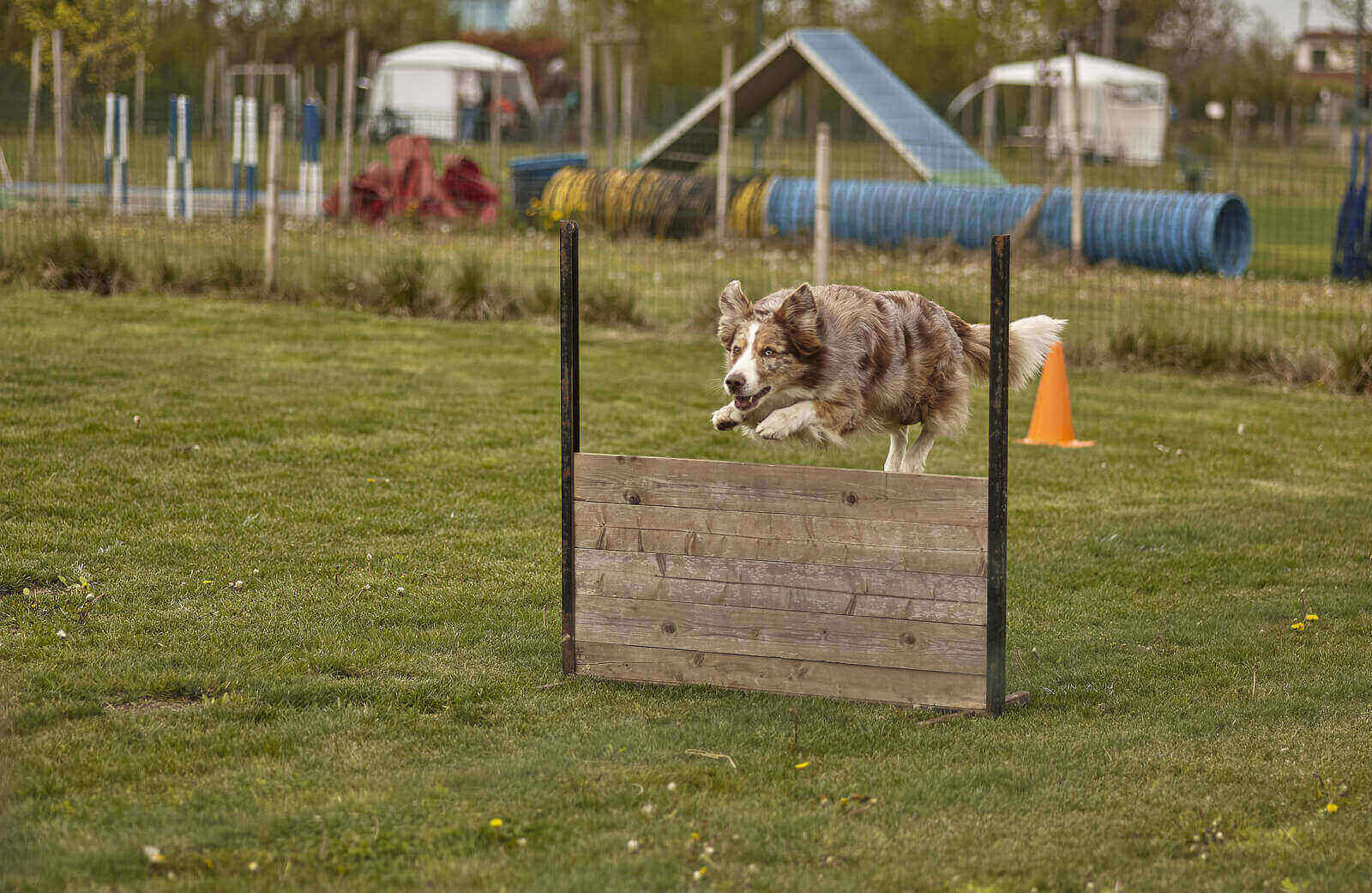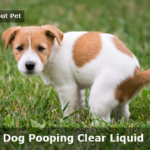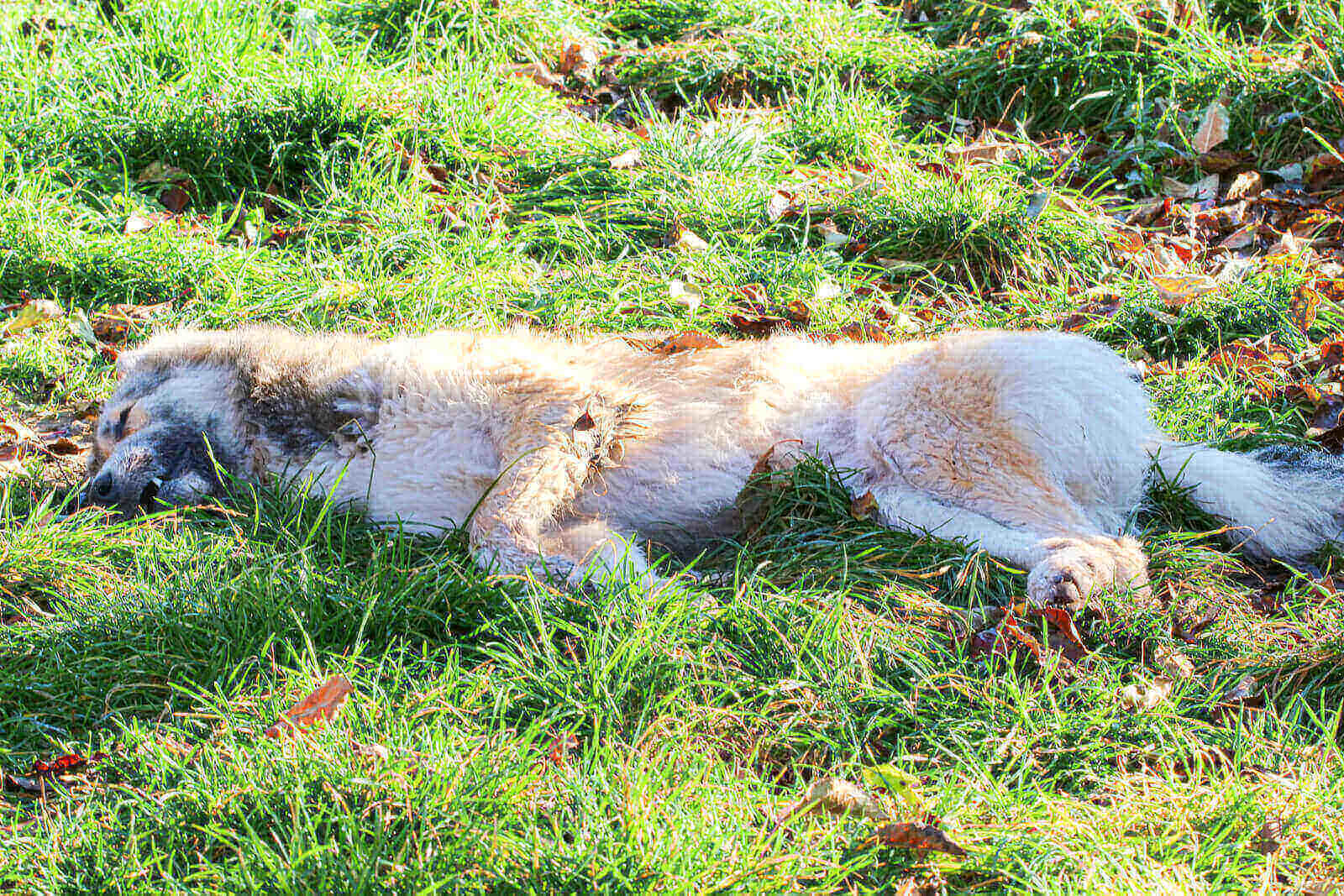Have you ever seen white specks in dog poop? Have you ever wondered what it might be and how your dog might have gotten it? You’re not alone. Many dogs suffer from white spots, and a few things can create poops with tiny white specks.
If your dog has a color at his poop other than his normal brown color, that is a signal of a problem. If you see white specks in dog poop, that can be a dietary problem, internal illness, side effects of medication, or parasite infection.

Several things need to be done when there are white specks in dog poop. Keep in mind that you do not have to panic whenever you see white specks in your pet’s poop immediately. All you have to do is learn from this article and figure out what triggered that reaction.
Why Are There White Spots In My Dog’s Poop?
White bits in dog poop can signify if your dog has a problem or isn’t in his food. Sometimes it’s not dangerous and normal, but that doesn’t mean it should be ignored.
White chunks in dog poop might be anything related to white. You have to look closely and make sure the white specks in dog poop are moving or not.
Looking closely and checking all over the poop is much better if you see white specks on the surface. This ensures whether your dog is free from disease or not because one way to see a dog’s health is to see its poop.
White Specks In Dog Poop – What Should I Do?
Apart from being noticed by the texture and smell, healthy dog poop can also be noticed by its color. If there are white specks in poop, you need to closely inspect the entire poop by looking inside.
It might sound gross, but it’s one way to ensure that the speckled dog poop isn’t harmful. You can check if the white specks in dog poop are moving or not.
If the white specks are moving, there is a possibility that your dog has parasitic infections, and if it is not moving or static, then it could be something else. You should take your dog to the Vet if the white speck moves and more than one.
White Specks In Dog Poop Not Moving – What Should I Do?
The white specks or dog poop white spots have many possibilities. If your dog has white specks in dog poop not moving, then you have to take a close look at it.
The first possibility, your dog is eating a high-calcium diet. Raw diets with high calcium content will leave a white color, and the stools are hard.
Another possibility, your dog eating a white object and not necessarily edible food for dogs. It might be socks, chalk, rocks, broken toys, or anything white.
If you encounter this, make sure next time no white appears. If it is still present, there is a possibility that your dog has digestive problems.
Small White Balls In Stool Symptoms
What are small white balls in dog poop? White ones are the fecal matter left behind by your dog’s waste. If it is small white balls in dog poop, then the chances are that your dog has not been very healthy lately.
Small white balls in dog poop are sometimes caused by an upset stomach or allergies. In other cases, the dog poop particles are dislodged from the body and end up in the toilet.
Or your dog eats things outside the dog owners’ supervision. Are the white specks in dog poop a pea size or bigger?
The white ball might be something that is passing through the intestinal tract as a whole. This is not a problem because it is out of the intestinal tract. The problem is if that thing is stuck in the dog’s body and can’t be digested.
White Specks In Dog Poop After Deworming – What Should I Do?
If you have treated dog has diarrhea with white specks, it is parasites infections and brought it to vet, but after finishing treatment, there are still white spots in dog poop after deworming, that can be a problem.
This is because after dewormed, there is a possibility that your dog will be exposed to worms again in the future. You need to determine how much time after deworming, and white specks are still on your dog’s stool.
If the distance is still a few days after deworming, that is normal and good, as there are no more worms in your dog’s stomach. But if it’s been a month after deworming, but there are still white specks in dog poop, your dog might be infected again by worms.
White Specks In Dog Poop After Eating Rice – What Should I Do?
If there are seeds like things in dog poop and they don’t move, then it’s probably a grain of rice that is hard for your dog to digest. It is also possible that your dog is eating grain seeds or rice seeds, so there are white seeds in dog poop.
You can’t do anything if your dog is eating grain seeds or seeds. All you have to do is make sure your dog is no longer close to those seeds. Then make sure the rice or grain you are going to give your dog is ripe to have no seeds left.
Why Is My Dog’s Poop White And Chalky?
White chunks in dog poop or chalky indicate that your dog has an internal illness. The indigestion problem will make the white specks in dog poop.
The dog’s liver will produce green-pigmented material (bile), which makes the poop color brown. If the liver is not producing bile, then the poop color can be gray or white. The high-calcium foods also cause constipation and make your dog poop white and chalky.
If your dog continues to emit white and chalky poops, then you should immediately take him to the veterinarian because it has something to do with liver disease or in his pancreas.
What Do Parasite Eggs Look Like In Dog Poop?
When you find white specks in dog poop, not worms, because they don’t move, then you must know exactly what white is in your dog’s poop. If you think it looks like a parasite egg, you need to check the entire poop of your dog and make sure there are any live parasites.
White specks in stool are parasites or parasite eggs, but they can be rice, grain, fly larva, or some other non-white food that dogs accidentally eat.
If you encounter white specks in dog poop such parasite eggs in large quantities, then you need to take them to the Vet as there is a chance that parasite eggs may be due to worms in your dog’s stomach.
White Seeds In Dog Poop – What To Do?
If you look at white stuff in dog poops, and it’s not worms, and it looks like seeds, it’s unprocessed foods like corn, nuts, seeds, quinoa, rice, and high-fiber vegetables. These foods can be passed directly without fully digesting in their intact form.
You can ensure hard white chunks in dog poop by separating them from the poop and trying to hold onto them. If it is hard and seed-like, then you can be sure it is undigested food, and you can be sure of what you have given your dog or what your dog is eating is beyond your control.

Reasons For White Specks In Dog Poop
Several reasons often cause white specks in dog poops, such as unprocessed foods, fly larvae, or tapeworm infections. Some of them can also cause white specks in dog diarrhea or other internal diseases. Let us know one by one the causes of white specks in poop dog.
Undigested Food
These are some foods that can pass directly through the digestive tract without going through the digestion process, so that dog poop looks like seeds.
The tiny white specks in dog poop can be any food that is not completely digested and only leaves a white color. For example, corn, quinoa, or rice allows undigested and looks like white specks in a dog stool.
Fly Larva
This can happen if you don’t check your dog poop right away, and the poop is lying around in your yard or the litter box. White spots in poops can fly larvae or maggot eggs because dog poops are a great place to leave larvae or eggs.
White specks in dog poop, fly larvae, are harmless because they appear outside the dog’s body and stick after the dog poop leaves. If you want to be observant, you have to look for fly larvae as soon as your dog pulls out the poop.
Dog Tapeworm Infection
Tapeworms are very annoying to your dog because they can cause vomiting, itchy bottom, and tiny white specks in dog diarrhea.
To treat your dog from the tapeworm, there are several things that must be done, from understanding where the tapeworm starts to bother your dog, what symptoms your dog is experiencing, what diagnosis and treatment your dog needs to do.
Tapeworm Transmission
A flea can be infected with tapeworm larvae. Your dog can swallow a flea while doing self-grooming. Inside the dog’s body, the tapeworm larva can develop into an adult tapeworm.
White bits in dog poop are one way to detect whether a tapeworm has developed in your dog’s body or not. If you don’t deworm immediately in the veterinarian, then the tapeworm can develop more in your dog’s body, and the white specks in the dog poop will take longer.
Tapeworm Symptoms
Parasites such as tapeworms can live in your dog for a long time before your dog develops health problems. But there will be some visible symptoms of your dog. Some of the tapeworm symptoms are:
- Weight loss
- Vomiting
- White specks in dog poop
- Itchy in the bottom of your dog
- Lose appetite
Immediately make a diagnosis to the Vet if your dog has shown some of the symptoms above so that treatment will be faster and your dog will recover faster from worm infections.
Tapeworm Diagnosis
If your veterinarian carries out a clinical diagnosis to your dog, the first thing to do is check the anus of your dog. Diagnosis can also be made in dog poop with white spots because your Vet can determine whether it is a larval tapeworm or a tapeworm that is still developing.
The entire adult tapeworm may also pass along with the stool or through vomiting because of a tapeworm disturbance in the stomach. If your dog vomits and it is clear that there is a tapeworm, of course, it is dangerous because surely there are already severe tapeworm infections.
Tapeworm Treatment
With advances in technology, deworming medications are much easier and simpler. The parasiticide can be given in the form of injections or tablets.
After the deworming process, using medications, slowly the tapeworm in the dog’s body will slowly dying. And for the next few days, your dog will issue a poop with tiny white specks, the result of a dead tapeworm in the stomach.
Don’t worry if you still see white specks in dog poop for a few days after deworming because not all tapeworms react immediately with parasiticides, especially adult tapeworms.
But you can continue the medications as recommended by Vet until your dog is completely free from tapeworm infections.
Tapeworm Prevention
Once you’ve made sure, there are no tiny white specks in stool, and you need to do tapeworm prevention. One of them is always brushing the dog’s coat and shampooing your dog regularly so that your dog does not swallow a flea while doing self-grooming.
White specks in dog poop can be traumatizing for dogs or their owners, so you need to pay attention to your dog’s behavior when outside, as well as anything the dog eats beyond your supervision.
Check your pet a month after deworming so that you know your dog is free from tapeworms and doesn’t get worm infections anymore.
Fruit Seeds
Several fruits have white seeds, and your dog cannot digest them. White seeds in dog poop are not dangerous because they do not go through a full digest process and go straight through in their intact form.
Tiny white specks in puppy poop seeds are not entirely white; some are left white because the contents are visible in the seeds. Make sure your dog doesn’t eat a lot of fruit seeds because they are choking hazards.
Is My Pet Dog Health Bad If I Find White Specks In Dog Poop?
You can see whether white specks in dog poops are problematic for your dog’s health or not. If you see seeds in dog poop, it is only because your dog cannot digest seeds, and it will not be a problem if there are only one or two seeds.
It will be a health problem for your dog if the color of the poop is all white because it is a sign of digestion problems. After all, the liver cannot produce bile.
There is also a sign that the pooping dog is unhealthy if you find white specks that can move because they are tapeworms or other types of worms lodged in your dog’s body.
Why Do We Need To Check Dog’s Stool?
One of the things that can ensure your dog is healthy from all diseases is the color of the dog’s stool. We already know some of the causes of white spots in dog poop. There are tiny white specks in dog poop not moving, and there are also those that move because they are tapeworms.
Some dog poop colors are problematic for your dog. Some of them are:
| Color | Cause & Effect |
| Green | Eating grass and can make an upset stomach |
| Maroon or Black | Sign of internal bleeding or small intestines |
| Red | Lower gastrointestinal tract or severe bleeding |
| Yellow | Liver, gallblader, or pancreas problems |
| White and Chalky | Your dog’s diet too high in calcium |
Can White Specks In Dog Poop Be Prevented?
There are several things dog owners can do to prevent white puppy poops. Some of them give the dog a healthy and well-balanced diet, good hygiene practices, grooming routine with shampoo to prevent flea from sticking to the dog’s coat.
Final Verdict On White Specks In Dog Poop
The normal dog poop color is brown because the dog’s liver produces green-pigmented material to turn brown. What does it mean when your dog’s poop is white? That means your dog is having a problem with its digestive system.
Many things can make a dog’s poop white in colors, such as undigested food, seeds, fly larvae, high-calcium foods, and tapeworm infections.

Poop coloration with white spots due to worms or white and chalky is a serious problem and should be treated so that your dog recovers quickly from the problem.
You can do prevention for your dogs so that their poops return to their normal color by keeping their environment clean, keeping your dog’s coat clean, and supervising their food, so they only eat a healthy, well-balanced diet.

Welcome to Learn About Pet. My name is Rajkumar Ravichandran and I love all pets, travel, and amazing food. I write about my passion and personal experience caring for multiple pets in this blog! ❤️
Post Disclaimer
DISCLAIMER: THIS BLOG OR WEBSITE, "Learn About Pet", DOES NOT PROVIDE YOU WITH MEDICAL ADVICE AND IS NOT A SUBSTITUTE FOR MEDICAL ADVICE. ALWAYS GET IN TOUCH WITH YOUR PERSONAL VETERINARIAN AND USE INFORMATION HERE AS GENERAL ADVICE.
The information, including but not limited to, text, graphics, images and other material contained on this website are for informational purposes only. No material on this site is intended to be a substitute for professional veterinary advice, food recommendation, diagnosis, or treatment. Always seek the advice of your veterinarian or other qualified health care provider with any questions you may have regarding a medical condition or for pet food related questions.







